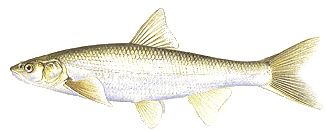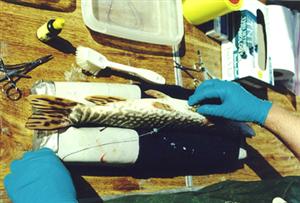Fish Radio Telemetry
Fish radio telemetry involves tracking the movement of fish using surgically-implanted radio transmitters. It is known that most large fish species that use the Athabasca River also live for part of the year in Lake Athabasca. The goal of the radio telemetry program is to see how much time these fish spend in the Athabasca River in areas near oil sands developments.
The following fish have been tagged in different studies:
 |
|
|
Walleye/Pickerel |
Northern pike / Jackfish |
 |
|
| Burbot | Flathead chub |
| Source of Images: The Iowa Department of Natural Resources | |
A number of fish in the Athabasca River basin have been fitted with radio transmitters and/or external tags. The tagged fish are part of a collaborative fish movement study for the Regional Aquatics Monitoring Program (RAMP) and Cumulative Environmental Management Association (CEMA). You can be an integral part of the study by reporting any tagged fish you catch.
The external tag is located near the dorsal fin and may be coloured brown/blue/yellow (RAMP) and pink (Syncrude). Radio-tagged fish have an antennae protruding from the side of their body (See examples on the right).
If you catch a fish with an external tag, please contact:
Alberta Sustainable Resource Development 780-743-7200
Please release live radio tagged fish and report the external tag number and fish information to help keep the study moving! If the fish is kept, please return radio tags. The radio transmitter can be found implanted in the abdomen of the fish.

Photo of a radio transmitter similar to those used in this study
Details about the RAMP study
The radio telemetry program was conducted from 2000 through 2001 in order to track the movement of fish from the Athabasca and Muskeg Rivers. Details and results from the study are listed below.
The RAMP 2000 program involved two radio tagging studies:
- Two sub-populations of longnose suckers (Athabasca River spawners and Muskeg River spawners) were radio tagged to see if the movement patterns differed between the sub-populations.
- Northern pike were radio-tagged in the Muskeg River to determine where they live in the winter.
Radio Telemetry Study Methods
- Fish were captured by boat electrofishing.
- Radio transmitters were surgically implanted into the body of relatively large, healthy fish.
- The transmitter had to weigh less than 2% of the fish body weight so it did not affect swimming ability.
- After a recovery period, the fish were released.
- The transmitters were guaranteed to last 443 days.
- Radio tracking surveys were conducted by Syncrude personnel to monitor the position of the radio tagged fish using a tracking receiver mounted on a fixed-wing airplane.
- The telemetry study area included approximately 335 km of the Athabasca River from Cascade Rapids to Lake Athabasca and the lower 35 km of the Muskeg River.
- Telemetry flights took place every 1-2 weeks from June 2000 through to June 2001.
Radio Telemetry Results
Athabasca River Longnose Sucker
- Fish were radio tagged after spawning in mid May near Mountain Rapids.
- Most of these fish moved to Lake Athabasca within 2-3 weeks after spawning.
Muskeg River Longnose Sucker and Northern Pike
- In late May, spawning fish were radio tagged in the Muskeg River downstream of Jackpine Creek.
- Most of these fish stayed in the Athabasca River during the summer and fall, returning to Lake Athabasca for the winter.
For more information:
See RAMP's Fish Health Advertisement.










jpg.300.-1.-514500562.jpg)